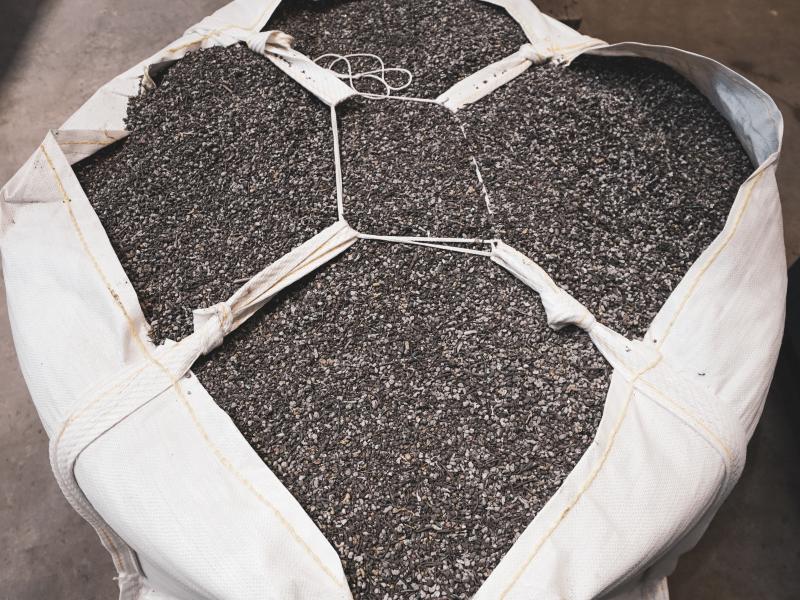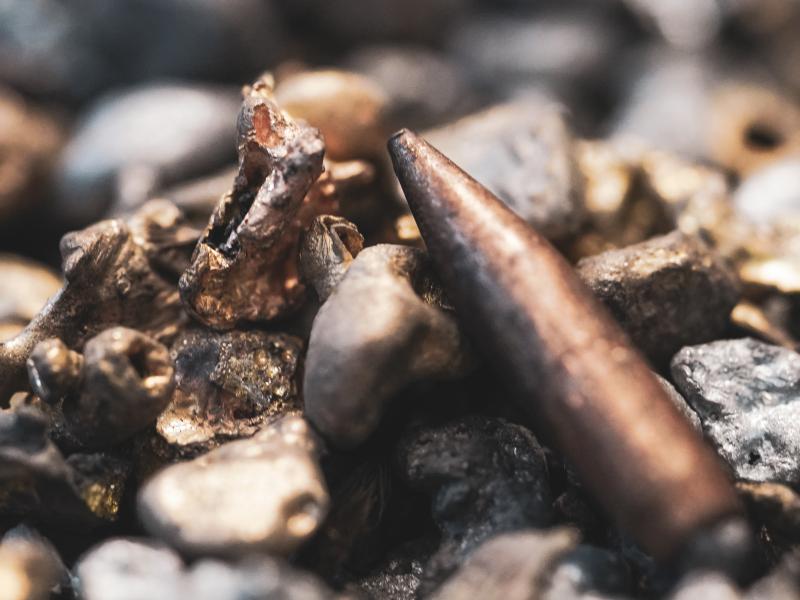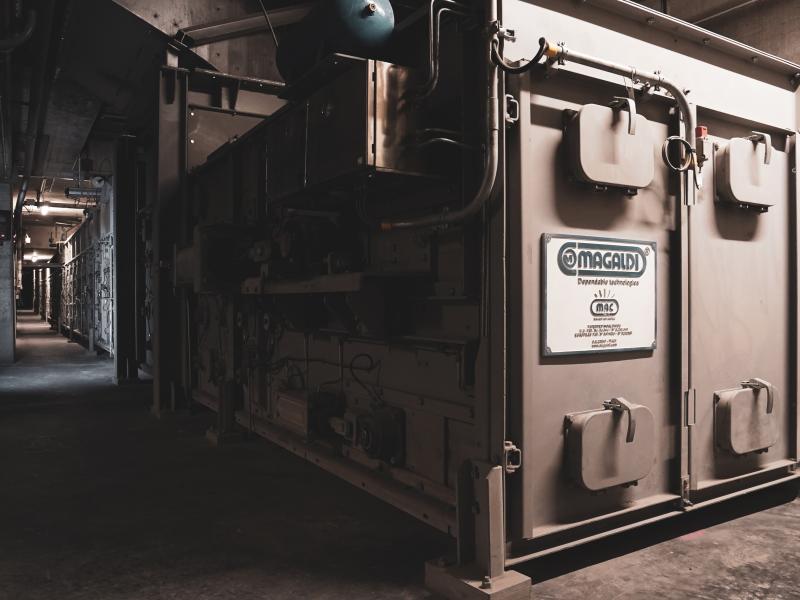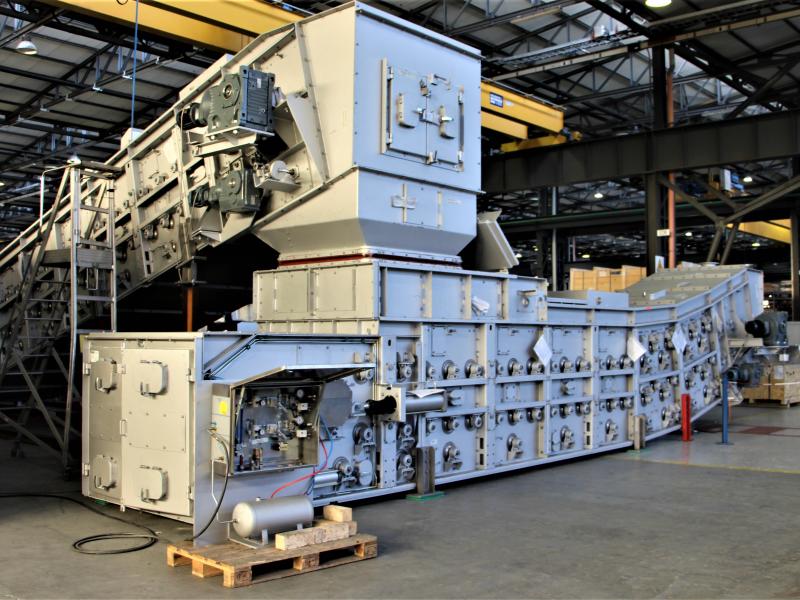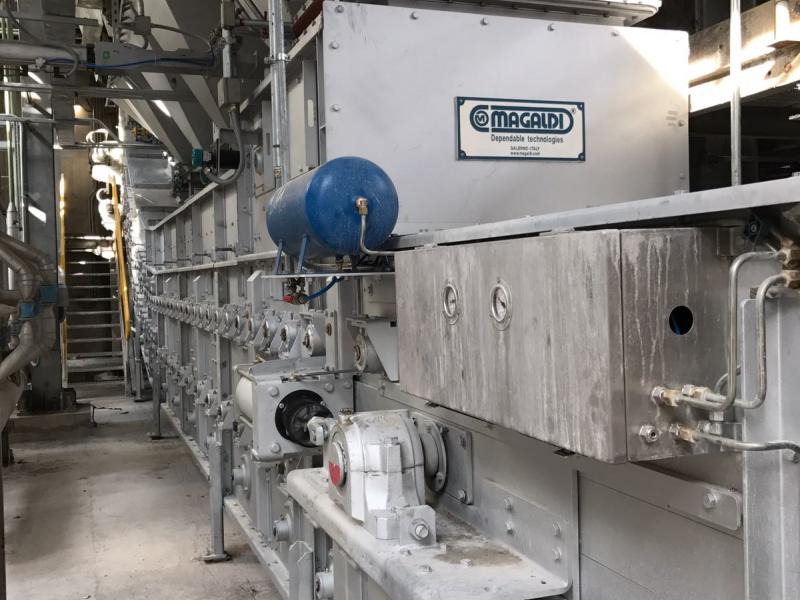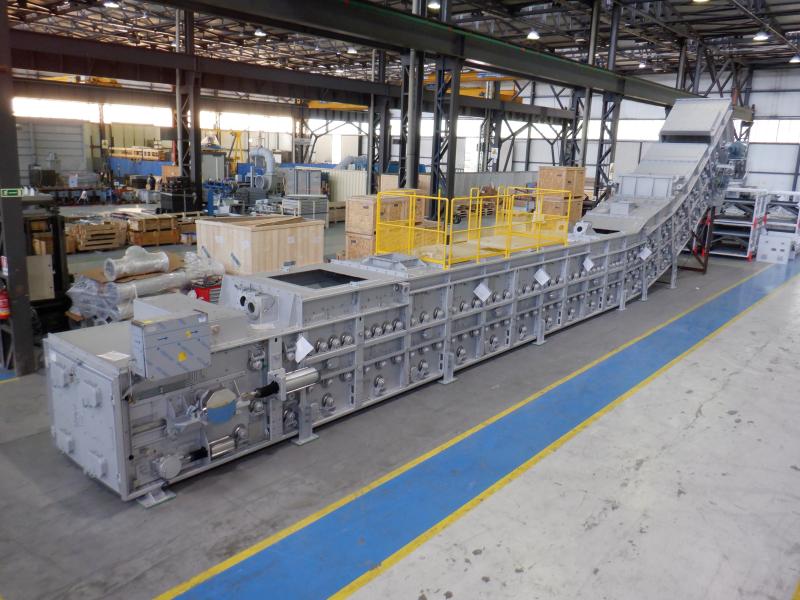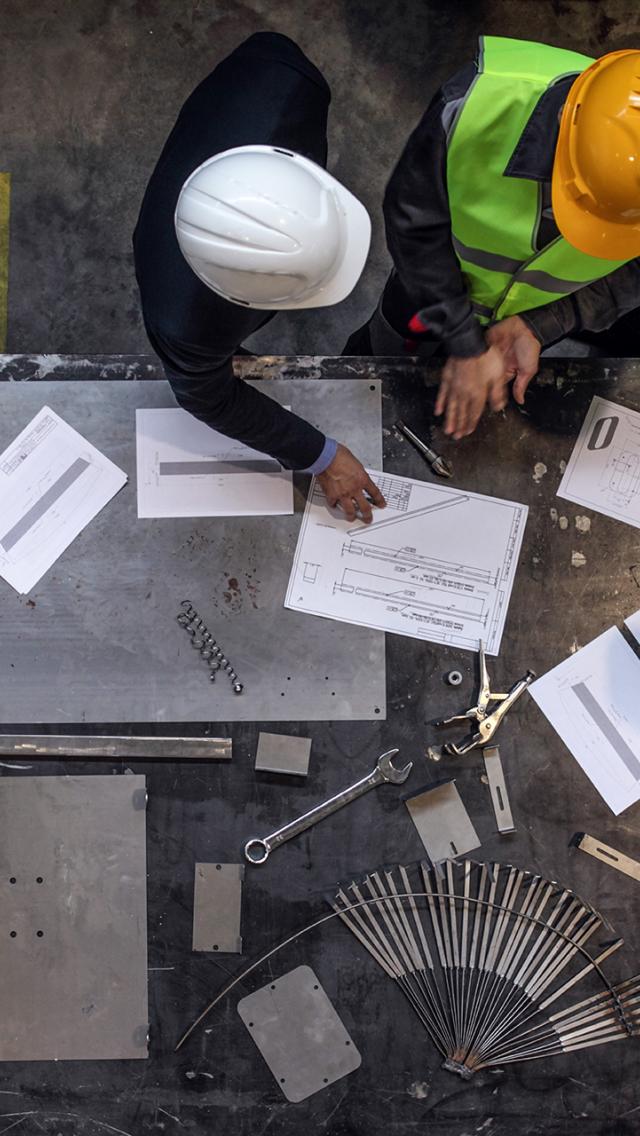The Ecobelt® WA system
A unique system for dry extraction, air cooling, and mechanical conveying of Incinerator Bottom Ash (IBA)
Water and related costs savings
With the Ecobelt® WA system, IBA is cooled and conveyed in a completely dry way. Water is replaced with a stream of ambient air as the primary cooling medium.
The result is the effective mitigation of the environmental impact and a high reduction in operating costs since there is no need to dispose of or treat water.
No tramp air in-leakage
Ash cooling is carried out by a counter-current flow of ambient air drawn into the equipment thanks to a negative pressure prevailing inside the Ecobelt® WA system. The air mass flow enters through accurately-sized air intake valves and is calculated based on the system arrangement and the design data. It allows for avoiding tramp air in-leakage.
Enhanced metal recovery
Downstream the extraction and cooling stages, IBA can be sent to an ash treatment collection plant or valorized in a compact treatment plant near the incineration area for metal recovery.
Dry extraction has proven to be the key to gaining a more effective separation and recovery of metals and minerals from the ash mixture.
The Ecobelt® WA improves the metal recovery rates by allowing the downstream recovery system to target smaller metal particles (< 0.2 mm). These recovery rates are significantly higher than the ones typically achieved from wet ash.
Also, the absence of water prevents further oxidation, providing cleaner metals that can go directly to the smelter.
The enhanced metal recovery process also reduces the carbon footprint. It is estimated that the entire bottom ash dry extraction and treatment cycle results in a reduction of approximately 1 ton of CO2 for every ton of ash treated.
Reduced ash disposal costs &
Potential reuse of the inert fraction
Since no water is added to the ash, it weighs roughly 20-30% less than wet ash, thus positively affecting transport costs.
As an alternative to landfilling, the residual mineral fraction can be used as a substitute in road construction or as a filler for conglomerates since it is much cleaner.
Increase in boiler efficiency &
TOC reduction
The Ecobelt® WA system allows for the recovery of waste energy in the form of ash sensible heat and chemical energy from the combustion of residual carbon in the ash. The recovery heat is transferred to the cooling air and introduced back to the boiler as preheated air, resulting in an overall increase in boiler efficiency and reduction of residual TOC (total organic content) and CO2 emissions.
The Superbelt® conveyor technology
The Ecobelt® WA system operates under difficult conditions, allowing the reliable transport of extremely hot, sharp, and abrasive bottom ash, in homogeneous or strongly fluctuating rates, thanks to the patented Superbelt® conveyor.
The use of the Superbelt® technology applied to dry ash handling provides a range of competitive advantages, including:
- higher dependability
- high temperature resistance
- high impact toughness
- negligible wear and no tear issues
- low power demand
- low and easy maintenance
- longer service life.
Some successful stories
Switzerland
Wet-to-Dry conversion
Waste-to-Energy plant
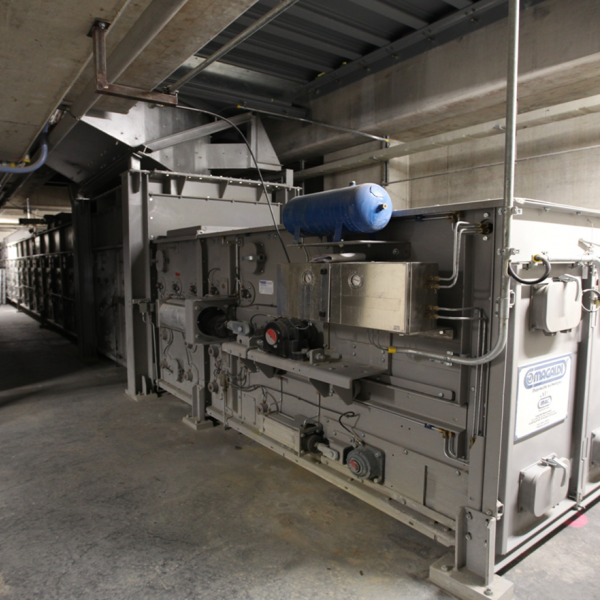
The dry IBA extraction has been the key feature to gaining a more effective separation and recovery of metals and minerals from the ash mixture.
The Customer
The WtE plant consists of 3 combustion lines burning household and industrial waste. It is the first fully-dry IBA treatment plant in the world.
The Challenge
The Customer was in need to replace an apron-based conveyor collecting the dry bottom ash from the combustion lines #2 & 3.
Some time later, Magaldi also carried out the wet-to-dry conversion of the bottom ash handling system on the incineration line #1.
The Solution
An Ecobelt® WA conveyor transports the dry bottom ash from lines #2 & 3 up to the dry ash treatment and the metal recovery facility.
Installed in place of a wet hydraulic ram and the downstream rubber belt conveyor, a second Ecobelt® WA transports:
- the hot bottom ash and the siftings ash produced by the line #1
- the hot bottom ash produced by lines #2 & 3.
The Ecobelt® WA system allowed overcoming all issues of poor reliability, unpredictable outage, and pulse waves back to the furnace, generated by the existing systems.
Italy
Dry Incinerator Bottom Ash handling
Waste-to-Energy plant
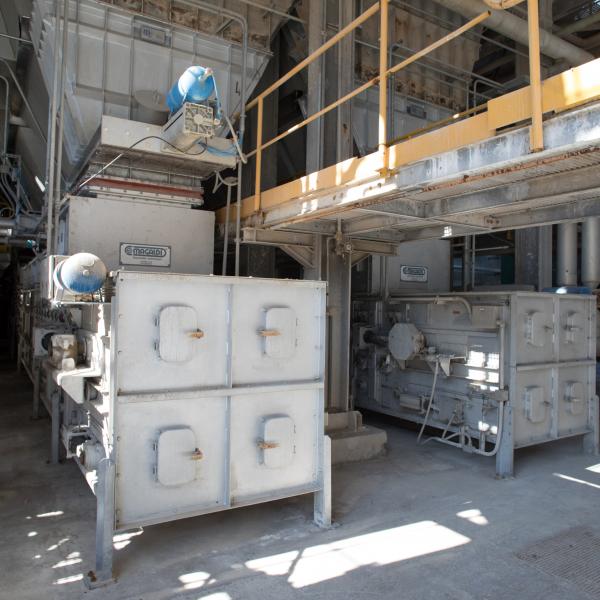
The Ecobelt® WA overcame maintenance headaches and all issues of poor reliability, unpredictable outage, and safety hazards.
The Customer
The WtE plant consists of 3 combustion lines, designed to thermally convert about 397,000 tons per year of secondary solid fuel (SSF).
The Challenge
Magaldi was selected to carry out the wet-to-dry conversion of the IBA handling system on the twin combustion lines #2 & 3. The existing submerged apron-based conveyors were placing serious problems:
- IBA with a high moisture content (>25%), thus increasing the disposal costs;
- frequent clogs affected the normal operation, posing safety hazards too;
- no maintenance could be carried out with the wet IBA system in operation.
The Solution
Each combustion line is equipped with 2 Ecobelt® WA conveyors which transport and cool down both the IBA and the sifting ash in a completely dry way.
Downstream the Ecobelt® WA conveyors, ash is conditioned by using a small amount of water to keep the dust down and allow safe transportation to the metal recovery facility.
Japan
Wet-to-Dry conversion
Waste-to-Energy plant
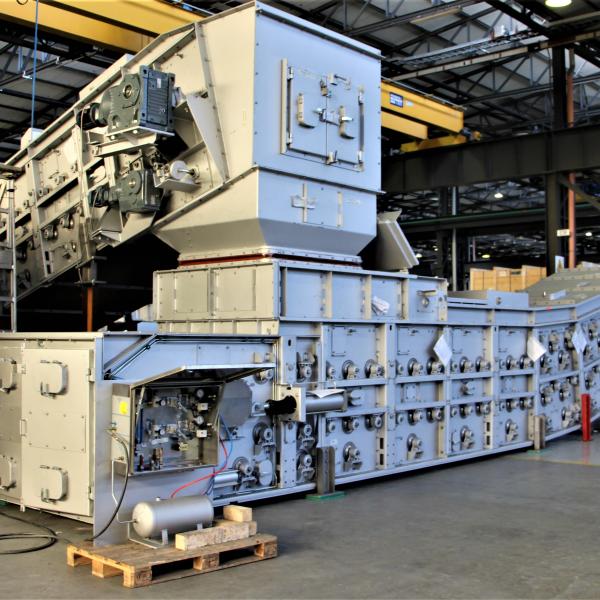
The Ecobelt® WA system has proven to be rated the best in the market in terms of operational costs and environmental protection.
The Customer
The plant consists of 2 combustion lines, each burning municipal solid waste up to 350 tons/day. The overall power output is 15 MWe.
The Challenge
The Customer aimed at replacing the existing wet submerged chain conveyors with a more dependable, environmentally friendly and easy-to-maintain technology.
The Solution
The Ecobelt® WA conveyors provided both technical and economic benefits for the IBA cooling and handling. The dry IBA handling systems do not require water both for cooling and conveying, thus leading to water savings and complete elimination of costs associated with wastewater treatment. Moreover, ferrous metals are recovered more efficiently from the dry IBA.

